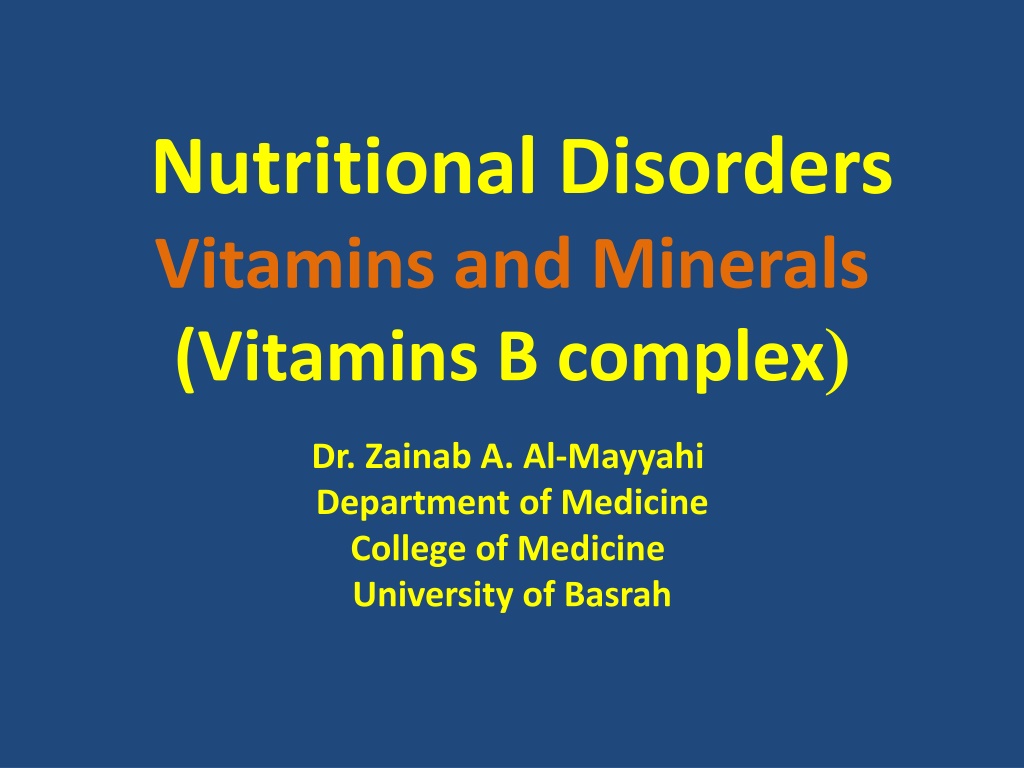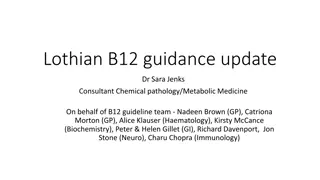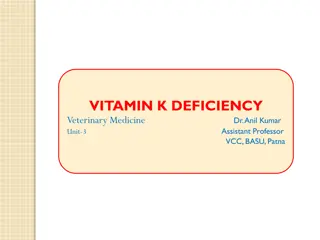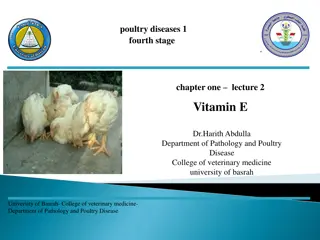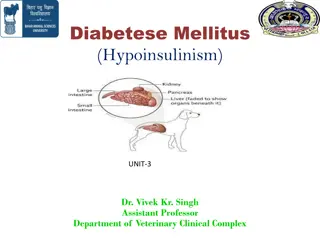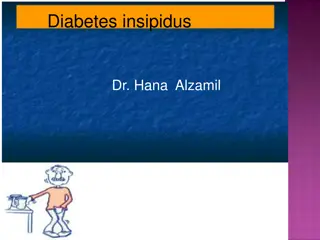Understanding Thiamine Deficiency and Beriberi: Causes, Symptoms, and Treatment
Thiamine (Vitamin B1) deficiency, often seen in conditions like alcoholism and poor dietary intake, can lead to serious health issues such as beriberi. This article delves into the causes, clinical features, and treatment options for thiamine deficiency, including the different types of beriberi and their symptoms.
Download Presentation

Please find below an Image/Link to download the presentation.
The content on the website is provided AS IS for your information and personal use only. It may not be sold, licensed, or shared on other websites without obtaining consent from the author. Download presentation by click this link. If you encounter any issues during the download, it is possible that the publisher has removed the file from their server.
E N D
Presentation Transcript
Nutritional Disorders Vitamins and Minerals (Vitamins B complex ( Dr. Zainab A. Al-Mayyahi Department of Medicine College of Medicine University of Basrah
Objectives By the end of this lecture you should be able to Define Vitamins Classify vitamins Identify causes of vitamins deficiencies Describe the clinical features of vitamins deficiency and excess Treat vitamins related nutritional disorders 2 University of Basrah /College of Medicine /Department of Medicine
Thiamine (Vitamin B1) Thiamine pyrophosphate plays an important role in energy (ATP) generation. Functions of B1: Decarboxylation of ketoacids (pyruvic acid, lactic acid). A coenzyme for a transketolase reaction (pentose and hexose metabolism). Plays a role in peripheral nerve conduction. 3 University of Basrah /College of Medicine /Department of Medicine
Sources and daily requirements Daily requirement: 2 mg/d. Food sources: yeast, meat, legumes, whole grains, and nuts. Milled rice or grains contain little thiamine. Tea and coffee contain thiaminases, which can destroy the vitamin. The body have limited stores of B1 so deficiency occur after one month of B1 free diet. 4 University of Basrah /College of Medicine /Department of Medicine
5 University of Basrah /College of Medicine /Department of Medicine
Thiamine deficiency Causes : Alcoholism. Poor dietary intake(rice based diet). Long-term parenteral nutrition. Chronic illnesses. Pregnancy. Chronic diuretics therapy. Heavy coffee and tea consumption. 6 University of Basrah /College of Medicine /Department of Medicine
Clinical features of thiamine deficiency In early stage anorexia, irritability and decrease in short-term memory. Prolonged thiamine deficiency causes beriberi , tow types of beriberi: Wet beriberi. Dry beriberi. 7 University of Basrah /College of Medicine /Department of Medicine
Clinical features of thiamine deficiency Wet beriberi : presents primarily with cardiovascular symptoms, due to impaired myocardial energy metabolism and dysautonomia, and can occur after 3 months of a thiamine-deficient diet. Patients present with an enlarged heart, tachycardia, high-output CHF and peripheral edema. 8 University of Basrah /College of Medicine /Department of Medicine
Clinical features of thiamine deficiency Dry beriberi : present with a symmetric peripheral neuropathy of the motor and sensory systems with diminished reflexes. The neuropathy affects the legs more than the arms. 9 University of Basrah /College of Medicine /Department of Medicine
Clinical features of thiamine deficiency Wernicke's encephalopathy: is a CNS syndrome caused by thiamine deficiency in alcoholics; nystagmus, ophthalmoplegia, ataxia, and mental impairment, it can be precipitated by large CHO dose without B1. Wernicke-Korsakoff syndrome : occurs when there is an additional loss of memory and a confabulatory psychosis. 10 University of Basrah /College of Medicine /Department of Medicine
Diagnosis of thiamin deficiency Assay of transketolase activity measured before and after the addition of thiamine pyrophosphate. Thiamine in serum or blood can also be measured by HPLC. Urinary thiamine excretion. 11 University of Basrah /College of Medicine /Department of Medicine
Treatment of thiamine deficiency Acute thiamine deficiency is an emergency whether cardiovascular or neurological. Treatment is 100 mg/d of thiamine parenterally for 7 days, followed by 10 mg/d orally until there is complete recovery. Improvement occurs within 24 hours. But Wernicke-Korsakoff psychosis may be permanent. 12 University of Basrah /College of Medicine /Department of Medicine
Riboflavin (Vitamin B2) Functions of riboflavin : Coenzyme in metabolism of fat , carbohydrate, and protein. Plays a role in drugs and steroid metabolism, including detoxification reactions. 13 University of Basrah /College of Medicine /Department of Medicine
14 University of Basrah /College of Medicine /Department of Medicine
Vitamin B2 deficiency Causes : rare in developed countries, mainly caused by under-nutrition and alcoholism, occurs together with other vitamins deficiencies. Clinical features : glossitis, angular stomatitis, cheilosis, skin lesions, corneal vascularization, anemia, and personality changes. 15 University of Basrah /College of Medicine /Department of Medicine
Vitamin B2 deficiency 16 University of Basrah /College of Medicine /Department of Medicine
Diagnosis and treatment Diagnosis : measurement of red blood cell or urinary riboflavin concentrations. Treatment : B2 replacement usually together with other vitamin B complex 17 University of Basrah /College of Medicine /Department of Medicine
Niacin (Vitamin B3) Niacin refers to nicotinic acid and nicotinamide and their metabolites. It is a precursor of NAD and NADP which are important in : 1. Numerous oxidation- reduction reactions and in DNA repair. 2. High doses of nicotinic acid (2 g/d) are used for the treatment of hyperlipidemia. 18 University of Basrah /College of Medicine /Department of Medicine
Sources and daily requirement Sources : milk, meat, fish, poultry, nuts and eggs. Niacin can be synthesized from tryptophan from vegetables sources but this reaction requires B6 and B2 Daily requirement : 15 -20 mg /day. Requirement increase in pregnancy and lactation. 19 University of Basrah /College of Medicine /Department of Medicine
20 University of Basrah /College of Medicine /Department of Medicine
Niacin deficiency (Pellagra) Causes of niacin deficiency: Dietary deficiency ( corn based diet). Alcoholism. Hartnup disease ( defect in tryptophan absorption) Carcinoid syndrome( increase consumption of tryptophan). B6 and B2 deficiency. 21 University of Basrah /College of Medicine /Department of Medicine
Clinical features of Pellagra Loss of appetite, generalized weakness and irritability, abdominal pain, and vomiting. Bright red glossitis. Dermatitis Diarrhea (in part due to proctitis and in part due to malabsorption). depression, seizures, and dementia. 22 University of Basrah /College of Medicine /Department of Medicine
Clinical features of Pellagra A characteristic rash, pigmented, scaling, in sun exposed skin known as Casal's necklace because it forms a ring around the neck. Pellagra = 4Ds dermatitis, diarrhea, dementia and death. 23 University of Basrah /College of Medicine /Department of Medicine
Diagnosis and treatment Diagnosis: Clinical features. Niacin metabolites assay in urine. Treatment : 100 200 mg of niacin three times daily for 5 days. 24 University of Basrah /College of Medicine /Department of Medicine
Niacin toxicity Doses > 50 mg may cause flushing, skin dryness, itching, parasthesia, headache, nausea, vomiting, and abdominal pain. Hepatic toxicity is the most serious toxic reaction due to niacin and may present as jaundice with elevated AST and ALT levels. 25 University of Basrah /College of Medicine /Department of Medicine
Pyridoxine (Vitamin B6) Function of B6: It is a cofactor for more than 100 enzymes involved in amino acid metabolism. Involved in heme and neurotransmitters synthesis. Involved in the metabolism of several vitamins like niacin. 26 University of Basrah /College of Medicine /Department of Medicine
Sources and daily requirements Sources : rich sources are legumes, nuts, wheat bran, and meat, although it is present in all food groups. B6from plants is less bioavailable than that from animal tissues. Daily requirements: 2 mg /d. 27 University of Basrah /College of Medicine /Department of Medicine
daily requirement 2mg/d 28 University of Basrah /College of Medicine /Department of Medicine
Pyridoxine deficiency B6 will affect the epithelial tissues, bone marrow and the nervous system. Causes of B6 deficiency include: Nutritional insufficiency. Drugs like isoniazid (INH). 29 University of Basrah /College of Medicine /Department of Medicine
Clinical features of B6 deficiency Glossitis, angular stomatitis, dermatitis. Microcytic, hypochromic anemia. Peripheral neuropathy, personality changes, depression, confusion and seizures especially in infants. 30 University of Basrah /College of Medicine /Department of Medicine
Diagnosis and treatment Diagnosis: low plasma level of pyridoxine. Treatment : B6 orally 50 mg/d. 31 University of Basrah /College of Medicine /Department of Medicine
Pyridoxine toxicity Chronic use of high doses of B6 > 100 mg /day can cause severe sensory neuropathy. Photosensitivity and dermatitis have also been reported. 32 University of Basrah /College of Medicine /Department of Medicine
Biotin (vitamin B7) Functions : plays a role in gene expression, gluconeogenesis, fatty acid and amino acid synthesis. 33 University of Basrah /College of Medicine /Department of Medicine
Sources of B7 Sources of vitamin B7 include fish, meat, soy, beans, yeast, cheese and milk. University of Basrah /College of Medicine /Department of Medicine 34
Biotin deficiency Clinical features : Biotin deficiency is rare, may presents with mental changes (depression, hallucinations), paresthesia, anorexia, nausea and a scaling, seborrheic, skin rash. Treatment : vitamin B7 replacement. 35 University of Basrah /College of Medicine /Department of Medicine
Folate (vitamin B9) The active form of folate and folic acid is tetrahydrofolate (THF) which is important in the synthesis of amino acids and nucleic acids. (DNA replication). 36 University of Basrah /College of Medicine /Department of Medicine
Sources and daily requirements Sources: green vegetables, yeast, liver, meat, citrus fruits, shellfish and whole grains. Daily requirements : 100 g /day. Body stores is 10 mg which is adequate for few months only. 37 University of Basrah /College of Medicine /Department of Medicine
38 University of Basrah /College of Medicine /Department of Medicine
Metabolism of folate Folic acid DHF DHF reductase THF DNA synthesis B12 Methyl THF 39 University of Basrah /College of Medicine /Department of Medicine
Folate deficiency Folate deficiency will lead to impaired DNA synthesis and this especially affects rapidly dividing cells in the bone marrow leading to a (megalobastic bone marrow). 40 University of Basrah /College of Medicine /Department of Medicine
Causes of folate deficiency Malnutrition. Malabsorption ( e.g. coeliac disease). Pregnancy ( increased requirements). Chronic hemolytic anemias ( thalassemia, sickle cell anemia ). Dugs: antiepileptics, trimethoprim, methotrexate. 41 University of Basrah /College of Medicine /Department of Medicine
Clinical features of folate deficiency The main clinical features is megaloblastic anemia. Hemolytic jaundice Glossitis, angular stomatitis and cheilosis. Bruising due to thrombocytopenia. low leukocyte count predispose to infections. 42 University of Basrah /College of Medicine /Department of Medicine
Diagnosis of folate deficiency Clinical features. Serum folate. Red cell folate. Blood indices and blood film morphology. 43 University of Basrah /College of Medicine /Department of Medicine
Treatment of folate deficiency Treatment of the underlying cause. Oral folic acid 5 15 mg daily for 4 months. Prophylactic Folic Acid for: Pregnant and lactating women. Chronic hemolytic anemias. 44 University of Basrah /College of Medicine /Department of Medicine
Cobalamin (vitamin B12) Functions : A coenzyme in folate metabolism. Important for DNA synthesis. Important for myelin integrity in the nervous system. 45 University of Basrah /College of Medicine /Department of Medicine
Sources and daily requirements Sources : food of animal origin, meat, fish, and dairy products. Daily requirements : 1-5 g /day. Body stores is 3-5 mg which is adequate for 2-3 years. 46 University of Basrah /College of Medicine /Department of Medicine
47 University of Basrah /College of Medicine /Department of Medicine
Absorption of vitamin B12 (cobalamin) Absorption and metabolism 48 University of Basrah /College of Medicine /Department of Medicine
Cobalamin deficiency Cobalamin deficiency will lead to: Megaloblastic changes in the bone marrow. Neurological changes due to defect in myelin synthesis. 49 University of Basrah /College of Medicine /Department of Medicine
Causes of Cobalamin deficiency Vegetarians ( vegans). Intrinsic factor deficiency ( gastroectomy, gastric atrophy, pernicious anemia). Diseases of the terminal ilium (Crohn s). Increased consumption of B12 in the gut (bacterial overgrowth, fish tape worm disease). Congenital defects in transcobalamin. 50 University of Basrah /College of Medicine /Department of Medicine
